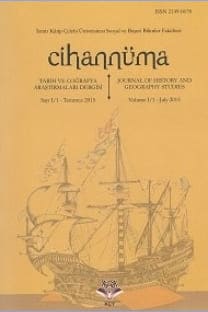Tanzimat’tan II. Meşrutiyet’e (1839-1908) Esnaf Hareketliliği, Devlet Kontrolü ve İstanbul
Modern devletler 17. yüzyılda ve sonrasında ortaya çıktılar. Sınırları belli bir coğrafi alana yerleşen bu devletler, büyüyen bürokrasileri ve orduları finanse etmek için teb'alarını/vatandaşlarını doğrudan vergilendirdiler. Bunun için kimin teb'a/vatandaş olup kimin olmadığını belirlemeleri gerekiyordu; çeşitli kanunları yürürlüğe koydular, sayımlar yaptılar ve iç/dış pasaportların da dâhil olduğu kimlik kartları çıkardılar. 17. yüzyıldan itibaren daha fazla genişleyemeyen Osmanlı İmparatorluğu, sınırları belli bir devlet olarak elindeki kaynakları etkin bir şekilde kullanma ihtiyacı duydu. Egemenliği altındaki insanların hareketlerini daha düzenli olarak kontrol etmeye ve gözetleme mekanizmaları geliştirmeye başladı. Elinizdeki bu makale Tanzimat’tan II. Meşrutiyet dönemine (1839-1908), İstanbul özelinde esnaf hareketliliğini ve devletin oynadığı rolü göstermektedir. Başkent İstanbul'a, kimin teb'a/vatandaş olup olmadığını belirleme ihtiyacına, devletin hareketleri denetlemesinin ekonomik boyutuna ve dolayısıyla çıkarlarının üst düzey esnaf ve tüccarla örtüşmesine, Şehremaneti'nin bir parçası olarak kurulan Esnaf Kalemi üzerinden lonca yöneticisi/kethüdanın değişen rolüne dikkat çekmektedir. Son olarak da 1877-1878 Osmanlı-Rus savaşını takiben ve esas olarak 1890’lar ve sonrasında Ermeni esnafın hareketliliğini örneklemektedir.
Artisans’ Mobility, State Control and Istanbul from the Tanzimat to the Second Constitution (1839-1908)
Modern states emerged from the 17th century and onwards. Settled in geographically defined spaces, these states directly taxed their subjects/citizens to finance growing bureaucracies and armies. For this, they needed to determine who was a subject/citizen and who was not; they passed various laws, conducted censuses, and issued identity cards, including internal/external passports. The Ottoman Empire, which could not expand anymore since the 17th century, needed to exploit its existing resources effectively as a state with defined borders. It began to control people’s movements under its rule on a more regular basis and to develop surveillance mechanisms. Emphasizing Istanbul, this present article shows artisans' mobility and the state's role from the Tanzimat to the Second Constitutional era (1839-1908). It pays attention to the capital city, Istanbul, the need to determine who was a subject/citizen or not, the economic dimension of state controlling of movements, and thus its interests coinciding with the upper-level artisans and merchants, the changing role of guild warden/kethüda through the Şehremaneti’s newly founded office called Artisan’s Office. Finally, it exemplifies Armenian artisans’ mobility following the Ottoman-Russian war of 1877-1878 and mainly from the 1890s and onwards.
___
- Abou-El-Haj, Rifa‘at ‘Ali, Formation of the Modern State: The Ottoman Empire, Sixteenth to Eighteeenth Centuries, Syracuse 2005.
- Başaran, Betül, Cengiz Kırlı, “Some Observations on Istanbul’s Artisans During the Reign of Selim III (1789-1808)”, Bread from the Lion’s Mouth: Artisans Struggling for a Livelihood in Ottoman Cities, (ed. Suraiya Faroqhi), Oxford 2015, s. 259-277.
